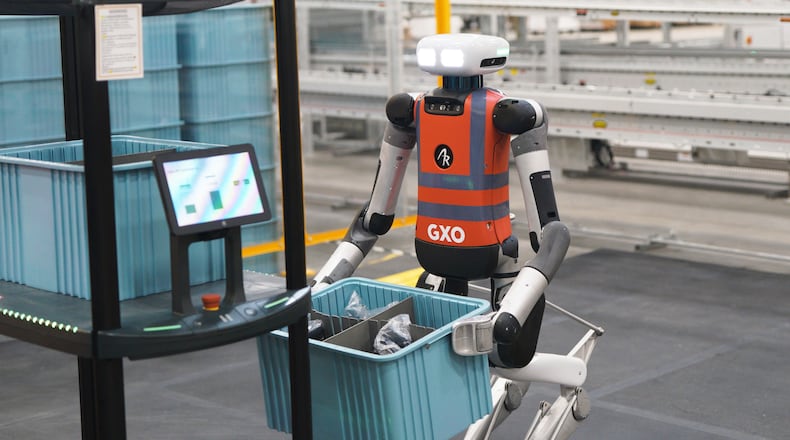Is it too late to loop in Isaac Asimov?
The late author, who wrote a series of novels about a world in which robots moved among, interacted with, supported and sometimes replaced humans, would likely have seen warehouse robots as the vanguard of what will inevitably be a smarter, stronger, more adaptable army of the machines.
In Asimov’s stories — later a film starring Will Smith — the machines were complex entities, not creatures, not humans, but not automatons either, although they were generally constrained by the Three Laws of Robotics, which compelled obedience and forbade harming a human being.
Those laws, which were legally mandated and embedded into the design of virtually all robots, do not yet exist in the real world.
But Digit does.
In what GXO Logistics calls “a proof-of-concept pilot,” a human-centric machine by that name is moving tote boxes in a Spanx warehouse in Flowery Branch that is managed by the global, Connecticut-based company. The 5-foot, 9-inch robot does “repetitive tasks” in a warehouse like moving items onto conveyor belts, according to Adrian Stoch, GXO’s chief automation officer.
The idea, he said, is to see how well the robot does those tasks, potentially freeing humans to do other, more valuable things. And as the program advances, the machine will take on more roles.
Digit is “multi-purpose,” so it can learn new tasks as needed, Stoch said. “This improvement frees up our team to focus on more valuable work, like personalization of product and packaging — which people do really well.”
Robots have been part of American factories for decades. But they mostly do not walk on two legs, lift boxes with two arms and turn a head to direct their two eyes.
In other words, they mostly look just like machines.
Digit-the-robot is the “first multi-purpose, human-centric robot that is made for work,” according to Agility Robotics, the Oregon-based company that made the machine.
While it’s called a pilot program, the machine is doing some of that work already, said Stoch. “So, this year, if you ordered a Spanx product over the last few weeks, Digit might have handled it.”
Economists and others have long speculated on the future of human workers when cheaper, more durable, more replaceable machines are available for many physical tasks. The much-ballyhooed advent of AI — artificial intelligence — only ratchets up the possibilities.
Some futurists with a dystopian bent have maintained that inevitable technological improvements will give machines so many capabilities that they will effectively displace a significant part of the workforce.
Agility declined to say how much Digit-the-robot cost.
But the company said that given an estimated lifespan of about 20,000 hours, Digit costs about $10 to $12 an hour to operate, already less than the median pay of a warehouse worker. And officials said increased production of the machines will cut that cost to $3 or $4 per hour.
While the robot could be cheaper than human labor, it is unlikely to take jobs, argued Agility Chief Executive Officer Damion Shelton.
In fact, it’s just the opposite — robots are going to fill positions that would otherwise be open, he said. “The Bureau of Labor Statistics (says) there are currently 1 million unfilled positions in logistics manual labor. There aren’t enough workers for these jobs.”
Indeed, optimists maintain that machines are an economic complement to people, dramatically improving productivity and standards of living. While machines have already replaced humans in many tasks, people have thus far continued working in record numbers, moving to different roles the way they did when automation came to farms and factories a century or more ago.
But with technology rapidly evolving, some experts say the outcome is uncertain.
And hovering over it all is the ghost of Asimov, who wrote some stories in which robots were helpful, some in which they were dangerous and at least one in which they were indistinguishable from humans.
Whatever the future may hold, it is on the way.
Agility’s CEO Shelton said that the firm is opening “a humanoid robot factory” early next year. The factory will have the capacity to produce 10,000 robots a year.
About the Author
Keep Reading
The Latest
Featured




